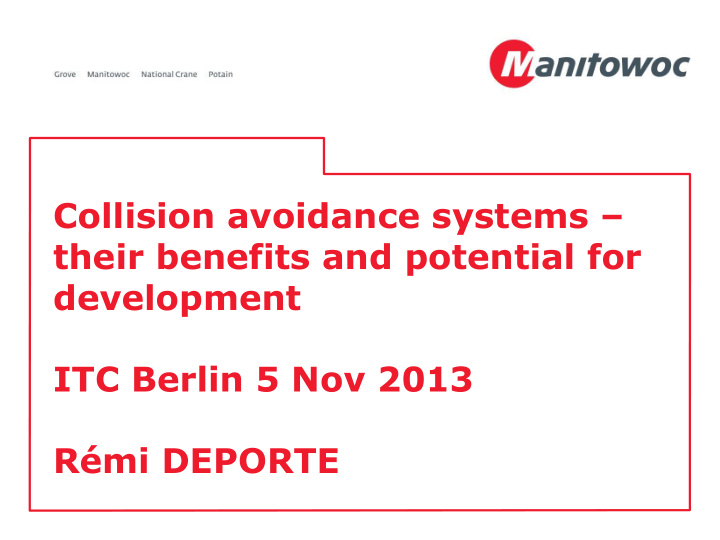



Collision avoidance systems – their benefits and potential for development ITC Berlin 5 Nov 2013 Rémi DEPORTE
Construction jobsite considerations Construction jobsite opportunities ▸ SAFETY C rane Human technology behaviour Construction ▸ TIME SCHEDULE ▸ COST Project Crane availability Crane productivity 2
Safety: Planning is key. Chose the right cranes for the jobsite • Position the cranes taking into • account obstacles such as: Power lines, buildings, other cranes. Think about jobsite organization , lift • planning, crane tasks … Plan implementation for zoning • and/or anti-collision system. 3
Safety: crane operator and crane technology ▸ Qualified Crane operator ▸ Embedded camera ▸ Indicators ▸ Crane Limit switches + MSWL ▸ Anti-collision ▸ Communication system 4
Anti-collision systems and Tower Crane Standard EN14439: « Each tower crane shall be capable of being equipped with an anti-collision device. This device shall stop motions to avoid entering in a forbidden area and allow the reverse movement . All connection points necessary for the installation of the device on the crane motion shall be assembled in a specific collector or on a dedicated cable. The specific collector or dedicated cable shall be installed on all cranes except on Self erecting cranes ». 5
Anti-collision systems and country regulations French labor regulation R. 4323-38. “When 2 or more pieces of lifting equipment are installed on a jobsite with their working areas interfering, measures must be taken to avoid collisions between loads and parts of lifting equipment.” Singapore Workplace Safety and Health construction Regulation. “For factories with more than one tower crane, crane to crane interference must be prevented by suitable devices, such as slew and trolley limit switches or anti- collision device .” Hong Kong Code of Practice for Safe Use of Tower cranes. “Suitable anti -collision system which can allow more than one tower crane in the overlapping zone without causing any collision should be provided”. Luxembourg labor ministry: “When cranes interfering together, it is required to install automatic devices to slow down and shut down movements to avoid any collision risk. In lots of countries, contractors decide to install anti-collision systems even if not compulsary. 6
Anti-collision - ongoing challenges Anti-collision manufacturers and tower crane manufacturers work together to define how the systems should work and define a list of parameters needed by anti-collision systems. Target: define the exchange of information in between tower crane and anti-collision system to better manage slow down / shut down of the movements and to better integrate anti-collision systems on tower cranes. 7
Anti-collision - ongoing challenges Today, collision avoidance systems are considered as driving aid . There are ongoing discussions around Anti- collision system’s Performance Level at the French Ministry of Labor. The performance level would be defined according to EN13849-1. 8
Anti-collision - ongoing challenges => Improve communication between advanced crane control systems and anti- collision systems. => Benefit of Crane electrical architecture based on “On board computer”. => Encourage Anti-collision systems pre- equiped from factory to reduce/eliminate the risks associated with “on - site” installation. => Simplify anti-collision system adjustment process. . 9
Anti-collision: tower and mobile cranes: accidents happen. “ The tower crane was slewing on the left when its jib hits a mobile crane jib telescoped a few minutes before.” In this case, 5 jib elements of the Tower crane out of a total of 8 were damaged and had to be changed. Proper planning can prevent this type of incident. Proper planning would include the appropriate use of operational aids as required based on the complexity of the jobsite. 10
Anti-collision systems product requirements Customers are more and more concerned with anti-collision systems and their ability to manage collision risks between TOWERS and MOBILES. Easy installation and calibration. Third dimension capabilities. Supervision of the entire jobsite through supervisor. + + + 11
Anti-collision Towers / Mobiles Even if there is no regulation today for mobile crane interference with tower cranes, there are greater customer expectations to have collision avoidance systems able to manage tower and mobile cranes. This is becoming reality with the implementation of GNSS technology (Global Navigation Satellite System). 12
Anti-collision Towers / Mobiles 13
Anti-collision part of jobsite management The anti-collision system is often seen on jobsites as a non-productive device slowing down crane performance. One of the key challenges is not only to provide real time, safe level positioning system, accurate to within centimeters, but also to help with enhancing crane productivity/availability and overall jobsite productivity. This can include various topics like: crane operator lift scheduler, instant status against BIM plan, shared information with head office management. 14
To keep in mind The future of the anti-collision systems is strongly related to: . Tower crane vs mobile crane management . Crane manufacturers involvement within dedicated anti-collision system interface. (especially on mobile cranes). . Integration of productivity enhancement functionalities associated with anti-collision capabilities. . Individual country regulations and the evolution of standards 15
Recommend
More recommend